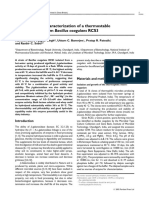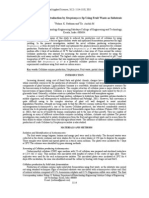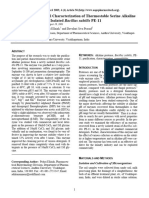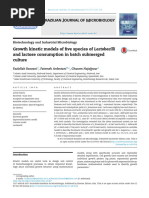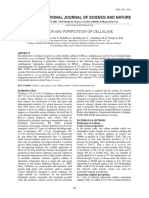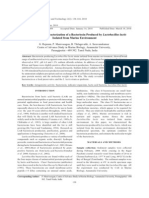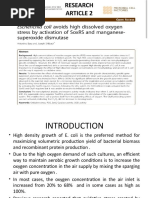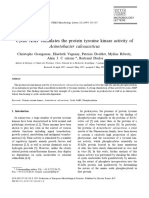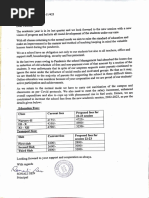β-galactosidase from Bacillus coagulans RCS3: Production and characterization of a thermostable
β-galactosidase from Bacillus coagulans RCS3: Production and characterization of a thermostable
Uploaded by
moogambigai smCopyright:
Available Formats
β-galactosidase from Bacillus coagulans RCS3: Production and characterization of a thermostable
β-galactosidase from Bacillus coagulans RCS3: Production and characterization of a thermostable
Uploaded by
moogambigai smOriginal Title
Copyright
Available Formats
Share this document
Did you find this document useful?
Is this content inappropriate?
Copyright:
Available Formats
β-galactosidase from Bacillus coagulans RCS3: Production and characterization of a thermostable
β-galactosidase from Bacillus coagulans RCS3: Production and characterization of a thermostable
Uploaded by
moogambigai smCopyright:
Available Formats
Biotechnol. Appl. Biochem.
(2002) 36, 1–6 (Printed in Great Britain) 1
Production and characterization of a thermostable
β-galactosidase from Bacillus coagulans RCS3
Navneet Batra*, Jagtar Singh*, Uttam C. Banerjee†, Pratap R. Patnaik‡
and Ranbir C. Sobti*1
*Department of Biotechnology, Panjab University, Chandigarh, India, †Department of Biotechnology, National Institute of
Pharmaceutical Education and Research, Mohali, India, and ‡Institute of Microbial Technology, Sector 39-A, Chandigarh, India
A strain of Bacillus coagulans RCS3 isolated from a present study describes a new thermophilic strain of Bacillus
hot-water spring produced significant β-galactosidase coagulans with thermostable β-galactosidase that shows
activity at 10 days of growth in a flask. While enzyme promise for the efficient hydrolysis of the lactose in milk and
production was maximum at 50 mC, the highest activity whey.
was at 65 mC, where the half-life was 2 h. A 2 mC decrease
in temperature increased the half-life to 15 h without
significantly changing the activity, suggesting that Materials and methods
63 mC is the temperature of preference compared
with 65 mC for a combination of good activity and Isolation and growth of the thermophilic micro-
stability. The β-galactosidase was also stable over organism
pH 5–8, with peak activity at pH 6–7. It was strongly A total of 16 clones of thermophilic microbes producing
and competitively inhibited by the hydrolysis product β-galactosidase were isolated from hot-water springs at
galactose. Bivalent cations (Cu2+, Ni2+ and Hg2+) in the Manikaran (Himachal Pradesh, India). The temperature of
concentration range of 0.5– 2.0 mM also inhibited the aqueous environment, the source of samples, ranged
enzyme activity. Both lactose solution and whey could from 45 to 90 mC, while the soil temperature was approxi-
be hydrolysed substantially within 36 h at 50 mC. The mately 42 mC. The clones were numbered RCS1–RCS16. As
thermostability and pH-stability and good hydrolytic a result of monitoring the production and stability of
capability make this enzyme potentially useful in the β-galactosidase obtained from different clones (results not
dairy industry. shown), RCS3 was selected for further exploration.
Strain RCS3, a Gram-positive, spore-forming microbe
Introduction was identified as Bacillus coagulans by the Microbial Type
Culture Collection and Gene Bank, Institute of Microbial
The ability of β-galactosidase (lactase ; EC 3.2.1.23) to Technology, Chandigarh, India, and assigned the accession
hydrolyse the β1 4-D-galactosidase linkage is one of the number 3244. The culture medium for enzyme production
most promising applications of enzymes in food processing contained, per litre : yeast extract, 5.0 g ; lactose, 10.0 g ;
[1–5]. The enzyme hydrolyses lactose in milk to glucose and K2HPO4, 2.5 g ; and MgSO4 : 7H2O, 0.5 g. The pH of the
galactose, thereby increasing its digestibility and sweetness. medium was adjusted to 6.8–7.0. The cultures were grown
This supplements the low levels of intestinal lactase, which in Ehrlenmeyer flasks at a shaking speed of 150 rev.\min with
limit the digestion of milk and can thus lead to gastrointestinal temperature maintained at 40 mC. After 10 days, the cells
diseases [6–11]. Lactase may therefore be usefully applied to were harvested by centrifugation at 10 000 rev.\min (C24
whey and its constituents to make higher-solid syrups, centrifuge ; Remi Equipments, New Delhi, India). The cell-
alcoholic beverages, animal feed and food desserts. A free supernatant was adjusted to 30–70 % saturation with
decrease in lactose can increase sweetness and decrease (NH4)2SO4. The precipitates were removed by centrifugation
grittiness [3,4,12]. at 15 000 rev.\min for 1 h and dissolved in 0.1 M sodium
β-Galactosidase is widely distributed in Nature and is phosphate buffer, pH 7.0, followed by dialysis overnight
produced by animals, plants and micro-organisms. While against two changes of the buffer. The dialysed samples were
different microbial sources [3,13,14] have been studied in used as sources of enzyme for characterization.
respect of this enzyme, very few products show good
activity at high temperature. Thermostability is an important Key words : lactose hydrolysis, inhibition, thermostability.
property, not only in food processing, but also in other Abbreviations used : ONP, o-nitrophenol ; ONPG, o-nitrophenyl
β-D- galactopyranoside.
biotechnological applications, because it decreases con- 1
To whom correspondence should be sent (e-mail
tamination and increases the shelf life of the enzyme. The rcsobti!panjabuniv.chd.nic.in).
# 2002 Portland Press Ltd
2 N. Batra and others
Enzyme assay partially purified β-galactosidase to 25 ml of reaction mix-
The enzyme activity was studied using the technique ture. The flasks were incubated at 50 mC and 100 rev.\min.
described by Griffith and Muir [15] with certain modifica- Aliquots (0.5 ml) were removed at regular intervals and
tions. The assay mixture (3.0 ml) containing 2.0 ml of 5.0 mM the glucose concentration was determined as described
o-nitrophenyl β-D-galactopyranoside (ONPG) in 0.1 M so- for the Glucose (Trinder) Kit no. 135-100 (Sigma). The
dium phosphate buffer, pH 7.0, and 1.0 ml of diluted enzyme percentage hydrolysis of lactose was calculated in terms of
was incubated at 60 mC for 10 min. A 2.0 ml portion of percentage of maximum efficiency. Lactose solution (1 %)
0.5 mM ice-cold Na2CO3 was then added and the A420 was was mixed with β-galactosidase and, after a sufficient period
read in a DU 640B spectrophotometer (Beckman) with of incubation and hydrolysis, the final solution was precipi-
appropriate substrate and enzyme blanks. o-Nitrophenol tated with acetone. The supernatant, along with standard
(ONP) was used as standard. sugars (lactose, glucose and galactose), was spotted on Kie-
To analyse the intracellular β-galactosidase, the cells selgel 60 P254 plates (Merck, Darmstadt, Germany). The
were washed twice with buffer and treated with toluene\ spots were developed in chloroform\acetone\water (6 : 7 : 1,
acetone mixture (2 : 1, v\v). After 5 min, the cells were by vol.). The plates were dried and sprayed with aniline\
centrifuged at 9000 rev.\min for 20 min, suspended in the diphenylamine\phosphoric acid (1 : 1 : 1, v\w\v) in acetone
buffer and assayed as described above with a suitable blank. and incubated at 100 mC for 10 min.
The activity of the enzyme was expressed in units, 1 unit
of enzyme being the amount that produces 1 µmol of
ONP\min per ml at pH 7.0 and 60 mC. The values shown in Results and discussion
the Figures are the means of three measurements in each
case. The time course of production of β-galactosidase is shown in
Figure 1. After 10 days, cultures of Bacillus coagulans RCS3
yielded 6.26 units of extracellular enzyme\ml of broth
Protein estimation culture. Following a lag period of 24 h, the activity of the
Protein concentration was determined by the method of enzyme increased rapidly and continued to increase after 10
Lowry et al. [16]. To prepare the standard curve, BSA was days. By contrast, intracellular β-galactosidase activity, esti-
used. mated from cell lysates, was nearly constant at about
0.42 units\ml throughout the fermentation period. This
observation and the constancy of cell density after 24 h
Optimum pH value and stable pH range
(Figure 1) suggest that β-galactosidase synthesis by this
The optimum pH for β-galactosidase activity was studied by
organism occurs largely after the cells have matured and it
assaying enzyme activity using the following buffers (0.1 M) :
is secreted out.
potassium acetate, pH 4.0–5.0 ; sodium phosphate, pH
Both growth and enzyme production remained stable
6.0–7.0 ; and glycine\NaOH, pH 9.0–10.0 (with suitable
dilution of enzyme in the same buffer).
Stability profiles with respect to pH were obtained by
incubating the enzyme in buffers at different pH values
(4 –10) for 24 h at 37 mC, followed by measurement of the
residual activity.
Optimum temperature and stability
The optimum temperature was determined by incubating
the assay mixture at different temperatures (30–90 mC).
Stability of β-galactosidase was followed similarly by incubat-
ing the enzyme at different temperatures, withdrawing
samples periodically and determining residual lactase activity
at 60 mC.
Hydrolysis of lactose
Figure 1 Time course of β-galactosidase production by Bacillus coagulans
Hydrolysis of lactose (1–5 % in phosphate buffer, pH 7.0) or RCS3 using 1 % lactose medium
whey (obtained from the local market and containing 3.5 %
Abbreviations : I.U., unit ; d, day.
lactose) was performed by adding 5 ml (32.2 units) of
# 2002 Portland Press Ltd
New thermostable β-galactosidase 3
Figure 2 Effect of initial pH on growth and production of β-galactosidase
from Bacillus coagulans RCS3
Figure 4 Optimum temperature and thermal stability of β-galactosidase
from Bacillus coagulans RCS3
increase in enzyme activity from 30 to 40 mC. From the data
of the day 10, this increase was 360 %, whereas the further
increase until the optimum temperature was just 7 %.
Similarly, the activities fall drastically on heating the culture
broth beyond 50 mC. For industrial production, these
observations imply that it might be preferable to operate
somewhat below 50 mC so that disturbances or limitations of
control actions do not cause a sharp decrease in enzyme
synthesis. This approach is analogous to the use of subop-
timal dilution rates in continuous fermentations so as to
avoid wash-out of cells.
The optimum pH for enzyme production was 6.0–7.0.
This is comparable with pH 6.0–6.4 reported for B.
stearothermophilus [17] and B. coagulans [18,19], and 7.0
Figure 3 Effect of temperature on the production of β-galactosidase by for B. subtilis [20]. While the activity declined sharply on
Bacillus coagulans RCS3
either side of this optimal range, a sudden increase was
observed at pH 9.0, suggesting a change in conformation.
This increase in activity from pH 8 to pH 9 was 23 % and
over a range of the initial pH 5–8 (Figure 2). Although the pH was reproducible, indicating that it was not an experimental
of the final medium after growth was 8.4 –8.9, for all starting error. This enzyme was more than 90 % stable within pH
values, maximum enzyme activity was attained with an initial range 6–9, after which there was a small, but perceptible, fall
pH of 6.8. The change of pH during fermentation followed to 86 % of the peak activity at pH 10. Just as for production,
that of cell growth, i.e. an early increase and then fairly the activity fell sharply below pH 6.0. This might be due to
constant values (Figure 1). denaturation of the enzyme. Similar observations have been
To study the effect of temperature of enzyme pro- reported for β-galactosidase from Bacillus sp. TA 11[21] and
duction, fermentations were carried out in the range B. macerans [22].
25–60 mC. While β-galactosidase activity increased with time Figure 4 displays the optimum assay temperature and
for all temperatures, 50 mC was the best temperature at all stability at different temperatures for enzyme generated at
times (Figure 3). An interesting feature of Figure 3 is the large the optimum temperature. The optimum temperature was
# 2002 Portland Press Ltd
4 N. Batra and others
65 mC, but more than 90 % of activity was retained at 63 mC
and 67 mC, thus allowing small variations. While B. circulans
has a similar optimum, this is the upper end of the range
55–65 mC [23]. Moreover, B. circulans is mesophilic, and for
thermophilic organisms the reported optima are a few
degrees lower than for this strain [18,19,23]. From the data
in Figure 4, the half-life at 65 mC was 120 min, whereas at
63 mC it was 15 h. The dramatic improvement in stability and
the detection of more than 90 % of the peak activity at 63 mC
imply that 63 mC may be the best overall temperature. The
half-life again increased significantly to 41 h at 60 mC, but
the activity was almost entirely lost at 70 mC. Griffiths and
Muir [15] observed a half-life of 83 min at 65 mC for β-
galactosidase from a Bacillus sp. and a Thermusspecies [24,26]
have been reported to produce more stable β-galactosidase
than that from Bacillus sp. [21,22].
As described above, β-galactosidase activity was as-
sayed by monitoring the hydrolysis of ONPG at concentra-
tions from 1 mM to 25 mM. Lineweaver–Burk plots (Figure
5) yielded straight lines with a common intercept on the 1\v
Figure 5 Lineweaver–Burk plot for Bacillus coagulans RCS3 β-galactosidase axis and different slopes for different values of inhibitor
for hydrolysis of ONPG
concentration. This indicates competitive inhibition by
galactose, which agrees with the observations of most other
authors [15,24,26–27] ; however, non-competitive inhibition
Table 1 Effect of concentration of carbohydrates on the activity of
β-galactosidase
in Aspergillus oryzae has been reported by Shukla and Caplin
[28]. The product of lactose hydrolysis, i.e. galactose and
Carbohydrate Concentrationa Relative activity glucose, inhibited the RCS3 β-galactosidase activity to
Control – 100n0 different extents (Table 1), as has also been observed in
Glucose 0n01 91n4 other microbial β-galactosidases also [21,24] ; however, in
0n05 89n1 Thermoanaerobacter TP6 B1 [25], glucose acts as an activator
0n10 87n9
over the concentration range 1–10 %. The inhibition was
Galactose 0n01 47n8
0n05 16n6 most pronounced in the case of galactose, which inhibited
0n10 8n6 91 % of the activity at a concentration of 0.1 M, while only
0n20 8n7 12 % of the activity was inhibited by 0.1 M glucose. To
Lactose 0n01 94n8 evaluate the values of the parameters in the hydrolysis rate
Raffinose 0n01 96n5
Maltose 0n01 92n6 equation, the following equation [27] for competitive
Sorbitol 0n01 96n9 inhibition was regressed non-linearly to the data :
Fructose 0n01 99n6
Sucrose 0n01 100n4 Vmaxs
Starch 5n0 % 100n3 vl (1)
[Km\(1+i\Ki)]+s
a
All concentrations are in M, except for starch.
Table 2 Percentage deviations of reaction velocities predicted by eqn. (1) from corresponding experimental values
i is the inhibitor (galactose) concentration in mM.
Percentage deviation
[ONPG]
(mM) i… 0 2 4 6 8 10 15 20
0n1 3n71 k1n70 k1n15 k4n07 k2n24 2n05 k7n19 k4n52
0n2 k5n11 k7n44 k5n95 k7n64 k7n15 k2n50 k8n16 k13n79
0n3 5n38 2n57 2n32 0n96 k0n91 4n05 k1n98 0n06
0n4 k2n17 k0n98 k2n70 k3n91 k1n24 k1n15 2n22 1n59
0n5 k0n24 3n42 2n65 6n92 2n88 k1n11 1n03 2n58
0n8 0n83 1n64 4n08 2n58 4n39 0n30 3n29 2n59
1n0 k0n43 k1n99 k3n00 k2n61 k2n95 0n03 k2n08 k1n86
# 2002 Portland Press Ltd
New thermostable β-galactosidase 5
Figure 7 Progress of enzymic hydrolysis of lactose (1–5 %) and whey
Figure 6 Experimental and predicted velocities for hydrolysis of ONPG by
permeate at 50 mC
β-galactosidase from Bacillus coagulans RCS3
Table 3 Inhibition and activation by metal ions (a) and other agents (b) of
β-galactosidase from Bacillus coagulans RCS3 deviations (Table 2) and from both the linearized (Line-
(a) weaver–Burk) plots (Figure 5) and the original non-linear
plots (Figure 6).
Relative activity
Table 3 shows the effect of different univalent and
Metal ion 0n5 mM 1n0 mM 2n0 mM bivalent cations (Table 3a) and other specific inhibitors and
Mg 2+
97n0 98n6 101n4
activators (Table 3b). No bivalent cation tested stimulated
Ca2+ 103n7 105n6 107n5 the enzyme activity, as also observed by Choi et al. [21] for
Mn2+a 102n3 104n7 105n6 a different thermophilic bacillus. Cu2+, Hg2+ and Na2+ acted as
Mn2+ 111n1 115n6 119n6
Al3+ 95n2 100n6 99n5
strong inhibitors, while Mn2+ in the form of chloride salt was
Na+ 97n1 98n4 99n7 a weak activator. A particularly useful property of our β-
K+ 94n2 95n4 97n3 galactosidase is the absence of inhibition by Ca2+, which is an
Co2+ 96n9 96n6 92n4
Fe2+ 90n7 90n0 82n9
important component of milk. Although reducing agents like
Cu2+ 102n3 9n7 8n9 dithiothreitol, 2-mercaptoethanol and cysteine have been
Ni2+ 56n0 40n2 23n7 reported [24– 26] to activate the enzyme, no such activation
Hg2+ 36n8 34n8 34n3
was observed in β-galactosidase from B. coagulans RCS3 ;
(b)
however, the chelating agent EDTA acted as weak activator
Relative activity at 20 mM.
The effectiveness of the enzyme in hydrolysing lactose
Other agent 5n0 mM 10n0 mM 20n0 mM
solutions and whey are examined in Figure 7. Hydrolysis of
EDTA 101n8 108n2 116n3 lactose was indicated by the formation of glucose and
Dithiothreitol 106n5 106n3 105n3 galactose on TLC, and it signifies the ability of β-galactosidase
2-Mercaptoethanol 95n2 110n3 99n2
Cysteine 94n3 95n5 97n3 to break the β1 4 linkage. More than 90 % hydrolysis of a
Control 100n0 100n0 100n0 1 % lactose solution could be accomplished in 36 h, and
a
As sulphate ; all others are chlorides.
substantial hydrolysis (77 %) was possible even at a con-
centration of 5 %. In spite of the presence of other
constituents, 65 % hydrolysis of commercial whey occurred
The values obtained for the parameters were : Vmax l within the same duration. A decrease in hydrolysis with
1.75 µmol\min per mg of protein, Km l 5030 µM and Ki l increasing lactose content should be expected, since lactose
7040 µM. Using these values, the predicted velocities agree and its products, galactose and glucose, inhibit the process
well with experimental values, as seen from the percentage (Table 1).
# 2002 Portland Press Ltd
6 N. Batra and others
Conclusions 8 Buller, H. A. and Grand, R. J. (1990) Annu. Rev. Med. 44,
The present strain of B. coagulans RCS3 can grow and 141–148
produce β-galactosidase at elevated temperatures (up to 9 Khedkar, C. D., Mantri, J. M. and Khedkar, G. D. (1994) Cult.
50 mC) over the range pH 5–8. The enzyme has maximum Dairy Product J. 29, 1–14
activity at 65 mC and pH 6.8, with a half-life of 2 h at this 10 Solomons, N. W. (1996) Rev. Invest. Clin. 48 (Suppl.), 1–13
temperature and 15 h at 63 mC. It can hydrolyse lactose 11 Inman Felton, A. E. (1999) J. Am. Diet. Assoc. 99, 481–489
solutions and whey efficiently and is not inhibited by Ca2+, a 12 Zadow, J. G. (1992) in Whey and lactose processing (Zadow
prime constituent of milk. However, hydrolysis is inhibited J. G., ed.), pp. 361–408, Elsevier Science Publishers Ltd., Oxford
by the product galactose and therefore fed-batch operation 13 Blankenship, L. C. and Wells, P. A. (1974) J. Milk Food Technol.
is to be preferred for controlled feeding of lactose. The 37, 199–202
advantages mentioned above and the extracellular secretion 14 Bacerra, M. and Siso, M. I. G. (1996) Enzyme Microb. Technol.
of the enzyme make β-galactosidase from B. coagulans RCS3 19, 39–44
a good candidate for the dairy industry. 15 Griffiths, M. W. and Muir, D. D. (1978) J. Sci. Food Agric. 29,
753–761
16 Lowry, O. H., Rosenbrough, N. J., Farr, A. L. and Randall, R. J.
Acknowledgments (1951) J. Biol. Chem. 193, 265–275
17 Goodman, R. and Pederson, D. M. (1976) Can. J. Microbiol 22,
N. B. and J. S. thank the University Grants Commission and 817–825
the Council of Scientific and Industrial Research (CSIR), 18 Long, M. E. and Lee, C. K. (1979) U.S. Patent 4,179,335
New Delhi, India, respectively for providing research fellow- 19 Lewin, R. E. and Mahoney, R. R. (1981) Antonie Van Leeuwen-
ships. hoek 47, 53–64
20 Anema, P. J. (1964) Biochem. Biophys. Acta 89, 495–502
21 Choi, J. Y., Kim, II, H., Lee, B. H. and Lee, J. S. (1995) Biotechnol.
References Appl. Biochem. 22, 191–201
22 Miyazaki, Y. (1988) Agric. Biol. Chem. 52, 625–631
1 Shukla, T. P. (1975) CRC Crit. Rev. Food Technol. 5, 325–356 23 Iida, T., Ozaki, S., Kotaka, T. (1980) U.S. Patent 4,237,230
2 Belem, M. A. and Lee, B. H. (1998) Cric. Rev. Food. Sci. Nutr. 24 Cowan, D. A., Daniel, R. M., Martin, A. M. and Morgan, H. W.
38, 565–598 (1984) Biotechnol. Bioeng. 26, 1441–1145
3 Richmond, M. L., Gray J. I. and Stine, C. M. (1981) J. Dairy Sci. 25 Lind, D. L., Daniel, R. M., Cowan, D. A. and Morgan, H. W.
64, 1759–1771 (1989) Enzyme Microb. Technol. 11, 180–186
4 Gekas, V. and Lopez Leiva, M. (1985) Process Biochem. 20, 26 Berger, J., Lee, B. H., Lacroix, C. (1997) Biotechnol. Appl.
2–12 Biochem. 25, 29–41
5 Garcia-Garibay, M. and Gomez-Ruiz, L. (1996) Rev. Invest. Clin. 27 Bowden, A. C. (1974) Biochem. J. 137, 143–144
48 (Suppl.), 51–61 28 Shukla, H., Chaplin, M. (1993) Enzyme Microb. Technol. 15,
6 Vera, T. H., Marteau, P. and Korpela, R. (2000) J. Am. Coll. Nutr. 297–299
19 (Suppl.), 165S–175S
7 Fischer, L., Scheckermann, C. and Wagner, F. (1995) Appl.
Received 8 November 2001\25 February 2002; accepted 11 March 2002
Environ. Microbiol. 61, 1497–1501
# 2002 Portland Press Ltd
You might also like
- Catalogue Ralph Lauren HomeDocument189 pagesCatalogue Ralph Lauren HomeSifu Trenoops75% (4)
- A Laboratory Manual of Physical PharmaceuticsFrom EverandA Laboratory Manual of Physical PharmaceuticsRating: 2.5 out of 5 stars2.5/5 (2)
- AS1412-Mabadi-ul - Fiqhiyyah (SYKRH)Document3 pagesAS1412-Mabadi-ul - Fiqhiyyah (SYKRH)Abdul GhaffarNo ratings yet
- Pricing Strategy of LenovoDocument5 pagesPricing Strategy of LenovoShriya Dhar50% (2)
- Batra 2002Document6 pagesBatra 2002guiervicalNo ratings yet
- Characterization and Identification of The Best Screened Indigenous Lactic Acid Bacteria Producing - GalactosidaseDocument7 pagesCharacterization and Identification of The Best Screened Indigenous Lactic Acid Bacteria Producing - GalactosidaseSepti SetiawatiNo ratings yet
- Biosynthesis of Protease From Lactobacillus Paracasei: Kinetic Analysis of Fermentation ParametersDocument5 pagesBiosynthesis of Protease From Lactobacillus Paracasei: Kinetic Analysis of Fermentation ParametersGovGovsNo ratings yet
- Optimization of The Fermentation Medium To Receive The Highest Biomass Yield by Bacillus Subtilis Natto and The Initial Test of Nattokinase YieldDocument6 pagesOptimization of The Fermentation Medium To Receive The Highest Biomass Yield by Bacillus Subtilis Natto and The Initial Test of Nattokinase YieldNguyễn Hữu ToànNo ratings yet
- Lactobacillus O2t: Enzyme Activities Affecting End Product Distribution by Plantarum in Changes in andDocument3 pagesLactobacillus O2t: Enzyme Activities Affecting End Product Distribution by Plantarum in Changes in andpriskilaputriNo ratings yet
- Bioresources.: Characteristics And Kinetic Analysis Of Β-Glucosidase (Mabgl) From Mucor Ardhlaengiktus Rsc1Document13 pagesBioresources.: Characteristics And Kinetic Analysis Of Β-Glucosidase (Mabgl) From Mucor Ardhlaengiktus Rsc1el batoNo ratings yet
- 2 KarasovDocument5 pages2 KarasovalvarezriNo ratings yet
- LactosacarosaDocument8 pagesLactosacarosaAriel plutarco cardoso herreraNo ratings yet
- Characterization of Industrially-Valuable Xylanopectinolytic Enzymes Produced Concurrently by A Novel Isolate of Bacillus PumilusDocument9 pagesCharacterization of Industrially-Valuable Xylanopectinolytic Enzymes Produced Concurrently by A Novel Isolate of Bacillus PumilusLiyin WongNo ratings yet
- BBB 0433Document8 pagesBBB 0433PapaAudyNo ratings yet
- Fermentation and Recovery of L-Glutamic - Acid - FromDocument8 pagesFermentation and Recovery of L-Glutamic - Acid - FromPrachi Bhoir100% (1)
- Protein Expression and PurificationDocument6 pagesProtein Expression and PurificationtzintzuntzinNo ratings yet
- Cellulase Enzyme Production by Streptomyces SP Using Fruit Waste As SubstrateDocument5 pagesCellulase Enzyme Production by Streptomyces SP Using Fruit Waste As SubstrateHamka NurkayaNo ratings yet
- Amylolytic Enzymes Produced by B. Amyloliquefaciens MIR41Document6 pagesAmylolytic Enzymes Produced by B. Amyloliquefaciens MIR41Guillermo Raul CastroNo ratings yet
- Lee Et Al 1998Document3 pagesLee Et Al 1998rinifiahNo ratings yet
- Adinarayana K Ellaiah P Siva Prasad D 2003 Purification and Partial Characterization of Thermostable Serine Alkaline Protease From B Subtilis PE-11Document9 pagesAdinarayana K Ellaiah P Siva Prasad D 2003 Purification and Partial Characterization of Thermostable Serine Alkaline Protease From B Subtilis PE-11Emmanuel Oscar ALBINES SECLENNo ratings yet
- Lactic Acid Production From Waste PotatoDocument14 pagesLactic Acid Production From Waste Potatohariss123a63No ratings yet
- Study_of_Lactobacillus_as_Probiotic_BacteriaDocument7 pagesStudy_of_Lactobacillus_as_Probiotic_BacteriakatiNo ratings yet
- Chen 1996Document4 pagesChen 1996mplatonosNo ratings yet
- 1 s2.0 S1517838216313740 MainDocument8 pages1 s2.0 S1517838216313740 Main7fkqx7zh7pNo ratings yet
- An Efficient DNA Extraction Method For Lyse Bacterium: Lactobacillus Casei, A Difficult-ToDocument6 pagesAn Efficient DNA Extraction Method For Lyse Bacterium: Lactobacillus Casei, A Difficult-Toandrea nettle bareaNo ratings yet
- Benzaldehyde L-PacDocument8 pagesBenzaldehyde L-Pacjatzire50% (2)
- Purification and Characterization of An Intracellular 13-Glucosidase From ATCC 393Document10 pagesPurification and Characterization of An Intracellular 13-Glucosidase From ATCC 393Anastasya AmandaNo ratings yet
- Proposal Project f4 DrafDocument6 pagesProposal Project f4 Drafaiman farhanaNo ratings yet
- Tuan. N. A., Et Al (2015)Document7 pagesTuan. N. A., Et Al (2015)nini.myNo ratings yet
- Is Beer A Source of Prebiotics?: Abigail J. Kanyer, Gail M. Bornhorst, Maria L. Marco and Charles W. BamforthDocument5 pagesIs Beer A Source of Prebiotics?: Abigail J. Kanyer, Gail M. Bornhorst, Maria L. Marco and Charles W. BamforthLuNo ratings yet
- Alkaline ProteaseDocument12 pagesAlkaline ProteaseKaviyarasu VelmuruganNo ratings yet
- Antimicrobial Activity and Characteristics of Bacteriocins Produced by Vaginal LactobacilliDocument7 pagesAntimicrobial Activity and Characteristics of Bacteriocins Produced by Vaginal LactobacilliManohar PattarNo ratings yet
- Sagar JABB 22Document9 pagesSagar JABB 22krkNo ratings yet
- Isolation and Purification of CellulaseDocument6 pagesIsolation and Purification of CellulaseMeshal NoorNo ratings yet
- Art 01Document12 pagesArt 01Cristian-Catalin GavatNo ratings yet
- Purification and Characterization of An Organic Solvent and Detergent-Tolerant Novel Protease Produced by Bacillus Sp. RKY3Document8 pagesPurification and Characterization of An Organic Solvent and Detergent-Tolerant Novel Protease Produced by Bacillus Sp. RKY3سید حسین عارفیNo ratings yet
- Purification and Characterization of A Bacteriocin Produced by Lactobacillus Lactis Isolated From Marine EnvironmentDocument7 pagesPurification and Characterization of A Bacteriocin Produced by Lactobacillus Lactis Isolated From Marine EnvironmentHoàng-NguyênĐặngNo ratings yet
- 2nd Oxidate StressDocument18 pages2nd Oxidate Stresssandhya namadaraNo ratings yet
- Hsu Et - Al 2007Document4 pagesHsu Et - Al 2007Nguyen PhungNo ratings yet
- Identification and Potential Biotechnological Characterization of Lactic Acid Bacteria Isolated From White Cheese SamplesDocument11 pagesIdentification and Potential Biotechnological Characterization of Lactic Acid Bacteria Isolated From White Cheese SamplesmalihatayabaNo ratings yet
- Artículo para Protocolo L KaseiDocument5 pagesArtículo para Protocolo L KaseiSelene MeztliNo ratings yet
- Polysaccharides Produced by Two Red Algal Strains Grown in Digestate With Potential Ability of Tumor Cell InhibitionDocument11 pagesPolysaccharides Produced by Two Red Algal Strains Grown in Digestate With Potential Ability of Tumor Cell Inhibitionjuivanova7No ratings yet
- Binding and Uptake of Wheat Germ Agglutinin-Grafted PLGA-Nanospheres by Caco-2 MonolayersDocument7 pagesBinding and Uptake of Wheat Germ Agglutinin-Grafted PLGA-Nanospheres by Caco-2 MonolayerszeminkNo ratings yet
- Effect ofDocument8 pagesEffect ofAriadna Zatyuri Zuñiga LlanosNo ratings yet
- Appl. Environ. Microbiol. 1992 Yang 3355 9Document5 pagesAppl. Environ. Microbiol. 1992 Yang 3355 9ani4 samNo ratings yet
- Bacillus PolyfermenticusDocument6 pagesBacillus Polyfermenticussi275No ratings yet
- Yu 2008Document6 pagesYu 2008nina hasanaNo ratings yet
- Extracellular Acid Protease From Rhyzopus Oryzae Purification and CharacterizationDocument5 pagesExtracellular Acid Protease From Rhyzopus Oryzae Purification and CharacterizationhuduhudNo ratings yet
- A New Method To Obtain B-Glucan From Saccharomyces Cerevisiae CellsDocument4 pagesA New Method To Obtain B-Glucan From Saccharomyces Cerevisiae Cellshuynhtanvu2011No ratings yet
- Experimental Work: Chapter No.3Document28 pagesExperimental Work: Chapter No.3saabiaanNo ratings yet
- Purification y Characterization of Acidothermophilic Cellulase Enzyme Produced by Bacillus Subtilis Strain LF53 P09Document9 pagesPurification y Characterization of Acidothermophilic Cellulase Enzyme Produced by Bacillus Subtilis Strain LF53 P09Walter Michel Mamani MamaniNo ratings yet
- Evaluation of Antidiabetic Activity of Bile From Gallus GallusdomesticusDocument23 pagesEvaluation of Antidiabetic Activity of Bile From Gallus GallusdomesticusIJAR JOURNALNo ratings yet
- TMP 633 EDocument5 pagesTMP 633 EFrontiersNo ratings yet
- Population Changes of Eubacteria, Sulfate-Reducing Bacteria and Methanogenic Archaea in An Anaerobic Reactor Processing Ethanol Distillery VinasseDocument13 pagesPopulation Changes of Eubacteria, Sulfate-Reducing Bacteria and Methanogenic Archaea in An Anaerobic Reactor Processing Ethanol Distillery VinasseyutefupNo ratings yet
- Ardestani Et Al., 2015Document8 pagesArdestani Et Al., 201515041168No ratings yet
- CaracterizacionDocument9 pagesCaracterizacionDavid SantiagoNo ratings yet
- Microwave-Assisted Extraction Combined With EnzymaDocument11 pagesMicrowave-Assisted Extraction Combined With Enzymaberbagi.biologiNo ratings yet
- °c/15psi) - Under This Condition, The Cellulose Content of Wheat Straw Was Increased byDocument9 pages°c/15psi) - Under This Condition, The Cellulose Content of Wheat Straw Was Increased byHet ThankiNo ratings yet
- Hwa 2012Document3 pagesHwa 2012Claudia GarcíaNo ratings yet
- Ren 2010Document6 pagesRen 2010Rizka Aulia RNo ratings yet
- s10068 016 0030 XDocument6 pagess10068 016 0030 X0231810025 YANERIS MARCELA MORELO BELLIDO ESTUDIANTE ACTIVONo ratings yet
- Esther CHAPTER THREE and FOUR projectDocument13 pagesEsther CHAPTER THREE and FOUR projectuniquedx3No ratings yet
- Janome Juno E1019 Sewing Machine Service ManualDocument17 pagesJanome Juno E1019 Sewing Machine Service ManualiliiexpugnansNo ratings yet
- Ysmael Maritime Corporation V AvelinoDocument3 pagesYsmael Maritime Corporation V Avelinojan christiane sale100% (1)
- Circular School Fees 2022 2023Document1 pageCircular School Fees 2022 2023CHANDANNo ratings yet
- Dayton 8078 DAYStripDocument5 pagesDayton 8078 DAYStripnsykNo ratings yet
- Personal Capacity To Sue or Be SuedDocument8 pagesPersonal Capacity To Sue or Be SuedArindam Aarav PrakashNo ratings yet
- Ielts Band 9Document4 pagesIelts Band 9anil basnetNo ratings yet
- 2 Makati Dev Vs TanjuatcoDocument1 page2 Makati Dev Vs TanjuatcoBec Bec Bec100% (1)
- Professional ReadingsDocument1 pageProfessional ReadingsIvy Tuando BacaniNo ratings yet
- Divorce CasesDocument15 pagesDivorce Casesjohn08sanNo ratings yet
- Perform Oracle Inventory Setup With ScreenshotDocument52 pagesPerform Oracle Inventory Setup With Screenshotsyedmehar100% (1)
- I 164 Riddle HymnDocument39 pagesI 164 Riddle HymnVíctor A. MtzNo ratings yet
- Short Story ReflectionDocument3 pagesShort Story Reflectionapi-489861652No ratings yet
- Seven Forms of Personal & Corporate Praise: SourcesDocument8 pagesSeven Forms of Personal & Corporate Praise: SourcesRobert k SibandaNo ratings yet
- Literature Review On Patient Management SystemDocument9 pagesLiterature Review On Patient Management Systemafmzvaeeowzqyv100% (1)
- Ramakrishna PDFDocument13 pagesRamakrishna PDFNamitaNo ratings yet
- Hagigah. A Translation of The T - Talmud. Hagigah. EnglishDocument192 pagesHagigah. A Translation of The T - Talmud. Hagigah. EnglishAdrinian100% (1)
- Course by Course Evaluation Report: U.S. Equivalence: Grade AverageDocument2 pagesCourse by Course Evaluation Report: U.S. Equivalence: Grade AverageBhageshwar ChaudharyNo ratings yet
- Macro FizaDocument7 pagesMacro Fizasameerchanna89No ratings yet
- MohoDocument15 pagesMohoJudy JneydNo ratings yet
- GE - LP11 Series 3-10KVA Technical InstructionsDocument37 pagesGE - LP11 Series 3-10KVA Technical InstructionsAsad IqbalNo ratings yet
- POSITIONDocument6 pagesPOSITIONImran YousufNo ratings yet
- Philippine Canadian Inquirer #589Document32 pagesPhilippine Canadian Inquirer #589canadianinquirerNo ratings yet
- Savage Worlds - Pirates of The Spanish Main - Adventure DeckDocument4 pagesSavage Worlds - Pirates of The Spanish Main - Adventure DeckPedro Naniero100% (2)
- Dark Tourism: Understanding The Factors That Create Memorable Experiences in The Case of MillenialsDocument80 pagesDark Tourism: Understanding The Factors That Create Memorable Experiences in The Case of MillenialsMichelle MoreiraNo ratings yet
- 3 Paper7892Document14 pages3 Paper7892yafanzyz725No ratings yet
- LoRa General PresentationDocument65 pagesLoRa General PresentationgsouleresNo ratings yet
- Climate Change ExplainedDocument2 pagesClimate Change ExplainedDexter RaboNo ratings yet




